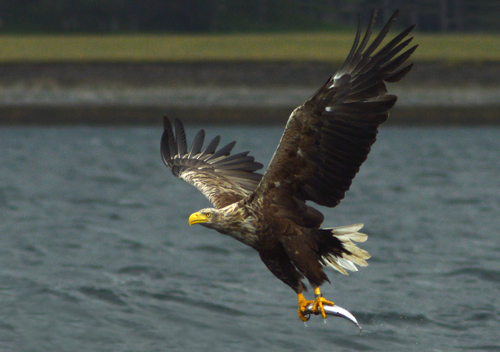
White-tailed Eagle
The White-tailed Eagle (Haliaeetus albicilla), also known as the Sea Eagle, is a majestic bird of prey renowned for its impressive size and striking appearance. It plays a crucial role as an apex predator in many coastal and wetland ecosystems across Eurasia. Once driven to near extinction in parts of its range, it has made a remarkable recovery in many areas due to conservation efforts. The species holds cultural significance in various regions, often symbolizing power and freedom, and features in folklore and national emblems.
66-94 cm
Length
182-244 cm
Wingspan
Least Concern
Conservation Status
Distribution
The White-tailed Eagle has a broad distribution across Eurasia, ranging from Greenland and Iceland in the west to Japan in the east. It is found primarily in coastal areas, large lakes, and river systems. Major populations exist in Norway, Russia, and around the Baltic Sea. They exhibit partial migratory behavior, with northern populations moving south for winter.
Lifespan
Typically 20-25 years in the wild, although some individuals may live longer.
White-tailed Eagle's Habitat
Habitat Types
Coastal areas, Large lakes, River systems, Wetlands, Estuaries
Climate Zones
Temperate, Boreal, Subarctic
Adaptations
White-tailed Eagles possess powerful talons for grasping slippery prey like fish. Their keen eyesight aids in spotting prey from great distances. They are also well-adapted to cold climates, with dense plumage providing insulation.
Variations
While generally considered monotypic (no recognized subspecies), some regional variations in size and plumage darkness exist. Greenland birds, for example, are sometimes considered slightly larger.
Appearance
Breeding Plumage
Adult plumage is largely consistent year-round.
Seasonal Feather Changes
Minimal seasonal variation. Juveniles have darker plumage and a dark tail, gradually acquiring the white tail with age.
Sex Based Plumage Differences
Adult males and females have similar plumage, although females are larger.
Notable Features
Large, broad wings, Distinctive white, wedge-shaped tail in adults, Powerful, yellow beak, Yellow eyes
Diet and Feeding
Primary Foods
Fish, Waterbirds, Carrion, Small mammals
Foraging Behavior
White-tailed Eagles are opportunistic hunters and scavengers. They often hunt by soaring and diving to catch fish near the water surface. They also steal prey from other birds (kleptoparasitism) and scavenge on carcasses.
Specializations
Their strong talons and sharp beak are perfectly adapted for catching and consuming fish and other prey. They have excellent eyesight for spotting prey from a distance.
Seasonal Diet Variations
Diet can vary seasonally depending on prey availability. In winter, carrion becomes a more significant food source, especially in areas with ice cover.
Behavior
Social Structure
Generally solitary or found in pairs, except during breeding season or at abundant food sources.
Communication
Vocalizations (various calls, including a distinctive yelping call), Aerial displays, Posturing
Migration
Northern populations are partially migratory, moving south to avoid frozen waters. Southern populations are often resident.
Territorial or Group Behaviors
White-tailed Eagles are highly territorial during the breeding season, defending their nesting area from intruders. Outside of breeding, they may congregate at good feeding locations.
Conservation
Threats
Habitat loss and degradation, Past persecution (shooting, poisoning), Environmental contaminants (e.g., organochlorines, heavy metals), Collision with wind turbines, Disturbance at nesting sites
Protection Programs
Reintroduction programs, Habitat restoration and protection, Legal protection (e.g., EU Birds Directive), Monitoring and research
Local National Laws
Protected under various national and international laws, including the EU Birds Directive and CITES Appendix I.
Population Trend
Increasing
Population Estimates
Estimated global population is around 20,000-40,000 individuals, with a significant increase in recent decades.
Interesting Facts
They have one of the largest wingspans of any eagle.
Their wingspan can reach up to 2.44 meters (8 feet), allowing for efficient soaring.
They are sometimes called 'flying barn doors' due to their large size and broad wings.
This nickname reflects their impressive appearance in flight.
They can live for over 20 years in the wild.
This relatively long lifespan contributes to their slow recovery from population declines.
They were successfully reintroduced to parts of Europe after near extinction.
Reintroduction programs in countries like Scotland have helped restore populations.
Faqs about White-tailed Eagle
What is the main threat to White-tailed Eagles?
Historically, persecution and habitat loss were major threats. While populations are recovering, ongoing threats include habitat degradation, environmental contaminants, and collisions with wind turbines.
Are White-tailed Eagles dangerous to humans?
No, White-tailed Eagles are not typically dangerous to humans. They generally avoid human contact.
How can I distinguish a White-tailed Eagle from other eagles?
Adult White-tailed Eagles are distinguished by their large size, broad wings, white wedge-shaped tail, and yellow beak. Juveniles have a dark tail and darker plumage.
Where can I see White-tailed Eagles?
White-tailed Eagles can be seen in coastal areas, near large lakes and rivers, and in wetlands across Eurasia. Good places to observe them include Norway, Scotland, and around the Baltic Sea.
Copyright @ Nature Style Limited. All Rights Reserved.
 English
English